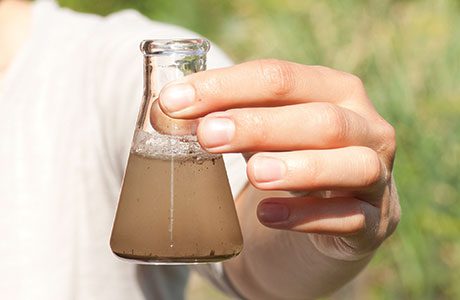 Steve Buss, Catchment Management Specialist at independent scientific environmental consultancy ESI, comments on recent findings that nitrate levels in groundwater are now levelling out. He explores further measures available to help minimise the problem.
Steve Buss, Catchment Management Specialist at independent scientific environmental consultancy ESI, comments on recent findings that nitrate levels in groundwater are now levelling out. He explores further measures available to help minimise the problem.
WITH many publications referring to the inexorable rise in nitrate concentrations in groundwater, and the uncertainty of when UK nitrate levels will peak, it’s a problem that has looked difficult to contain. The capital investment required to maintain drinking water quality for nitrate alone is estimated to be between £5 –£12million every year, in the UK, with the high carbon and operating costs of these plants also of concern.
But it seems nitrate concentrations in some of the worst affected groundwater sources in England may now be levelling out. Engagement and collaboration with those inadvertently affecting the water supply can help further reduce groundwater nitrate concentrations and essentially save bill-payers millions of pounds.
“Nitrate (NO3) is an inorganic compound that can arise both naturally and artificially in the environment, and occurs as part of the nitrogen cycle during the bacterial breakdown of animal and vegetable proteins and ammonium compounds. Nitrate contamination of drinking water has long been recognised as a public health issue, and the UK and European standard for the concentration in drinking water is 50 parts per million (50mg/l), with water companies required to take remedial action to ensure the water is safe for human consumption.
Why is it dangerous?
The compound can pose a threat to drinking water mainly because it’s highly soluble and once ingested breaks down to nitrites which can pose health risks. For instance, very high levels can cause methemoglobinemia (blue baby syndrome) in infants and young children, and can potentially be fatal. Although nitrate doesn’t pose a direct threat to older children or adults, the presence of the component in the ground does indicate the possible existence of other contaminants, such as pesticides, and can also reveal the overall quality of the groundwater.
Whilst nitrate is naturally present in the soil, the majority of nitrate in groundwater is the direct result of farming, with the compound being one of the main constituents of fertiliser. Nitrate concentrations in soils steadily increased following World War II due to intensification in farming, however it wasn’t until between 1975 and 2004 the true extent of contamination was realised because of nitrate leaching delaying its emergence in groundwater.
Since 1975, around 50 groundwater sources have been removed from use in the UK because of high levels of nitrate, which amounts to 140 million litres a day of the public water supply being lost. With 75% of the public water supply in the South East and 35% of England and Wales as a whole relying on groundwater, groundwater is a major national resource, so for the sources that are still in operation, water companies are required to take remedial action either blending the water with a lower source or using specialised water treatment to reduce concentrations.

The costs of cleaning up
The process of remediating nitrate contaminated water is carbon intensive, contributing to the total energy used by the water industry (which accounts for around three percent of the country’s total energy consumption). The remedial costs of rectifying nitrate in groundwater to the UK water industry is currently £120 million a year, the same as total water bills for half a million households, with the cost passed onto the end user. For instance, Cambridge Water announced plans to invest £7.84 million on nitrate removal plants between 2010 and 2015, with the costs passed on to its users resulting in increases of 7.3% on the average customers’ yearly bill.
Peak nitrate? When?
Many have labelled the ongoing trend of rising nitrate concentrations in groundwater as the ‘nitrate time bomb’ as it’s unclear when the concentrations will peak and how high they could get. However, a review of data for the 44 worst affected groundwater sources in the Midlands and North West indicates that many of the concentration trends have already levelled out or are beginning to decline. The reduction and levelling out in nitrate contamination in groundwater is in no small part down to stabilisation in recommended fertiliser applications to arable crops and the reduction of its application to grasslands, and from around 1980 halving the amount of fertiliser which was applied to pastures nationwide.
Government schemes
The Government and its agencies have also played a huge role in helping to reduce the nitrate concentrations in groundwater with a succession of schemes including Nitrate Sensitive Areas (NSA), Nitrate Vulnerable Zones (NVZ), safeguards and environmental stewardship schemes. The NSA scheme for example was the result of a series of large scale experiments which offered payments to farmers in return for complying with rules for the use of fertiliser and manure. A Nitrate Vulnerable Zone (NVZ) is designated where land drains and contributes to the nitrate found in ‘polluted’ waters, and those who don’t comply with the guidelines may be prosecuted or fined. Currently, around 55% of England and Wales and 14% of Scotland are designated NVZs, and the measures adopted in these areas will have reduced the amount of nitrate infiltrating the groundwater.
Engaging with farmers
Either way, the stabilisation and slight declines in nitrate concentrations across some parts of the UK are a positive starting point for engaging farmers in discussions on how to reduce nitrate inputs (and impacts) even further – using the methods explored by the Government (NSA and NVZ schemes are a starting point). A significant amount of progress has been made over the last 30 years, primarily as a result of robust legislation and a greater understanding of hydrogeology and groundwater contamination. There is still a great deal of nitrate in the system and a lot being applied to farmland, but if we can stabilise the rising trends, reverse stable trends, and accelerate declining trends, this may allow water companies to defer or avoid further major investment in nitrate treatment plants and ongoing operational/carbon costs, which can not only save water company customers millions of pounds, but reduce carbon emissions too.”

• Founded in 1996, ESI Ltd offers a combination of leading-edge services in the technically complex and rapidly developing fields of groundwater science and risk assessment. A team of over 50 technical specialists represents “one of the most important centres of groundwater and land quality knowledge in the UK”, says ESI. For more information, please visit www.esinternational.com.







